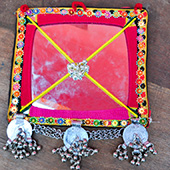Lambanis are also known as Banjaras. They belong to a tribal group with nomadic heritage who migrated from Marwar and resided in southern and middle India. Lambanis/Banjaras are usually found in Odisha, West Bengal, Bihar, Himachal Pradesh, Madhya Pradesh, Gujarat, Andhra Pradesh, Tamil Nadu, and Karnataka. The women of this community hold loyalty to their traditional form of costume, which is the most colourful and elaborate of any tribal group in India. Lambani embroidery and Kutch embroidery looks similar because of its mirror work, but shells and coins used for Lambani work are different in style. Even the stitching pattern is also different from Kutch embroidery. This practice of hand embroidery and mirror work is mostly used on the traditional dresses that are given to their daughters for their weddings. These conventional clothes reflect their love of life that has been evolved across the centuries to suit the social conditions and local climate. Lambanis are believed to be the descendants of Roman gypsies of Europe who migrated from Afghanistan and settled in the deserts of Rajasthan and many other states of India many years ago. They are very famous for their adventurous style of living and colourful costumes.
Lots of accessories with bright coloured costumes are the first things that strike the mind when thought about the people of Lambanis in India. Lambani women dressing is the most colourful and elaborate attire compared to other tribal communities of India. They are habituated to wear clothes like Ghaghra, Kanchidi, and odhani. Ghaghra is a skirt embellished with round-shaped mirrored glass with the borders embroidered in green and mustard colour threads, which is done on coarse red, black and white cotton cloth. These skirts are usually of ankle-length, which enables them to expose the ornaments of legs. Lambani skirts are embellished with appliques as well. These skirts are worn from the waist that covers half the body below the waist. The traditional Lambani Ghaghra/skirt forms a perfectly circular piece when spread over the floor. Kanchidi is an upper garment of the body known as ‘blouse’. It is a tight-fitting garment that covers the front part of the body and leaves the back bare, which can be tied with the cords. These cords are also ornamented with cowries and beads. Odhani/chatiya is a covering that measures two and a half meters in length and one and a half meters in width. This garment is designed to cover the upper part of the body. One end of odhani is tucked on the left side of the skirt and goes over the head and droops loosely on the right shoulder. Even this garment is elaborately embroidered in traditional Lambani style. The part of the chatiya that covers the head is bordered with beads and disc that hangs on the forehead to frame the face. Along with this traditional attire, Lambanis also wear the prettiest anklets made of silver, brass, cowries, animal bones, ivory, and nowadays plastic.
Lambani embroidery stands unique in its own way. It consists of random designs with a bright colour combination that is so traditional to their tribe. The motifs are done all over the base fabric. Geometrical patterns like circles, squares, rectangles, and triangles are made with heavy embroideries with colourful threads and embellished with beads, mirrors, shells, etc. Triangular shaped appliques are also used as borders in it. Lambani embroidery, to a large extent, comprises the quilting technique that is done on the edge of the garment known as “Katta”. Lambani embroideries are made using various types of stitches. Nearly 14 types of stitches are used in this embroidery. Namely: Bakkya, bhuriya, gadri, jollya, kans, kaudi, kilan, maki, nakra, pote, relo, suryakanti maki, tera dora and vele. These include running stitch that often seems like small dashes. These are done using contrast coloured threads. Other than that chain stitch, satin stitch, herringbone stitch, and buttonhole stitches are also used. Horizontal patterns, criss-cross patterns, and zigzag patterns are created by using these stitches. Lambanis mostly use red and blue colours. The basic fabric used for making embroidery is either cotton or power loom fabric. It is dyed using chemical colours or vegetable dyes made from natural elements such as kattha, pomegranate peel, and rathanjot, etc. In Karnataka, some of the villages around Hampi like Keri tanda, Khadirampur, etc. and Yadagiri practice Lambani embroidery. The products embellished with this art like bed sheets, cushion covers with subtle colour combinations have now reached all over the world. In contrast, the bags with heavy Lambani embroidery in flashy colours are the most favorite among the tourists.






